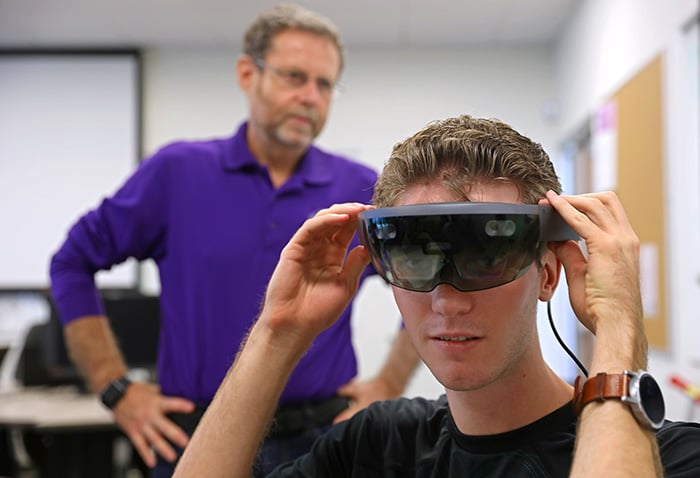
By Lana Sweeten-Shults
GCU Magazine
For as long as he can remember, Dr. Isac Artzi has been fascinated with the Star Trek Holodeck, where characters can escape their own reality by nuzzling up to virtual reality.
He can imagine being suddenly transported, like Capt. Jean-Luc Picard, from the 24th century to a 1940s-style gangster adventure. Or the Renaissance. Or a 20th century football game.
That fascination might be why Artzi, the College of Science, Engineering and Technology’s Computer Science lead, is so drawn to the Microsoft HoloLens, a self-contained holographic computer in the form of spacey-looking smartglasses that allow the wearer to interact with holograms -- programmed, not-really-there images visible only through the glasses.
“This (the HoloLens) is the baby step for that,” said Artzi. “My grandkids will look at this as such an ancient device. The Star Trek Holodeck will become a reality, I believe, in my lifetime.”
It is through the HoloLens that Grand Canyon University computer science students are taking their own baby steps through the world of virtual reality, and they’re doing it in a way that only GCU can do it: by integrating faith and science.
Artzi was looking for a unique way to weave GCU’s Christian worldview into the discipline of computer science.
“I’m very interested in the Bible, but not just the faith side of the Bible. I’m interested in the history and the linguistic history of events and the history of the language. And I’m very interested in how things came to be,” he said.
He thought, why not take Bible stories and have computer science students bring them to life through virtual reality?
Students in Artzi’s Human-Computer Interaction and Communication class have been delving into the Virtual Reality Bible Project since the beginning of the semester.
Seven groups of students, three to a team, have been busy programming stories such as the parting of the Red Sea, Jonah and the whale, Peter walking on water, Noah’s Ark and the birth of Jesus.
Leticia Galarza, a junior computer science major, squinted her eye at the scene on her laptop during one Monday morning class. In it, a “mini Moses” stood on the shores of a GCU student-approved Red Sea.
The team, which completed the storyboard for its project at the outset of the class, was in the midst of downloading a tool kit that would allow the HoloLens to map out an area on which to display the scenes. The students created visuals using Unity and the C-Sharp programming language and also had coded parts of their project in Microsoft Visual Studio.
Galarza pondered the next step: dressing up like Moses and other characters and scanning their images into the computer using a 3D camera “and actually putting ourselves in the scenes.”
She was excited about the possibilities of adding her vision to the text from the Bible: “What will the user take from this that they wouldn’t have taken from the actual text when they read it? So little things, in Unity, we can have it so. You can have a bird flying and have it pop up a text or a thought bubble. It’s adding little thoughts and adding little aspects you really wouldn’t think of when reading the text.”
Then there’s the other side of the Virtual Reality Bible Project. Galarza’s classmate, Trevor Godfrey, relayed how it is a clear way GCU incorporates Christian worldview into his coursework.
He sees computer science as “actually benefiting the world as a whole, in the sense that new technologies can help advance health care — can help advance humankind.”
“This is, honestly, probably going to be the coolest project I’ve worked on,” he said.
****
Related content:
3TV Arizona's Family: "Big Man on Campus: GCU Virtual Reality"
GCU Today: "Mixed reality virtually pumps up S.M.U.R.F. students"
GCU Today: "GCU talks desert plants, virtual reality at conference"















